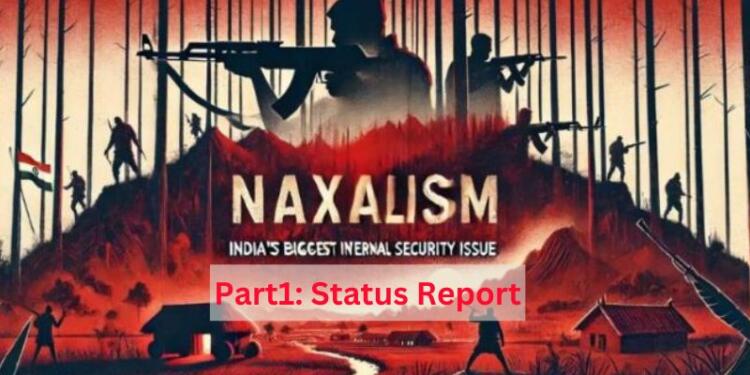The graph of Naxalism has been going down at a faster pace since the last decade. The intensified efforts in dealing with the Maoist menace is part of central forces’ campaign to completely eradicate it from the territory of India by 2026.
This was voiced by Union Home Minister Amit Shah recently who gave a deadline of March 2026. As part of these efforts, 16 Naxalites were killed in Chhattisgarh’s Gariaband on Wednesday. The operation was a major success as 12 of 16 killed carried a cumulative bounty of over Rs 3 crore.
Prominent among them was Chalapathi, also known as Ramchandran, Pratap Reddy, Appa Rao, and Ravi, a member of the central committee of the outlawed CPI (Maoist), who carried a reward of ₹90 lakh.
Notably, Gariaband is located at Chhattisgarh-Odisha border and is a nerve to interstate Naxalite movement.
The intensity of the operations can be understood by the fact that in less than a month this year, as many as 42 Maoists have been neutralised in Chhattisgarh. Last year, the combined toll was 219.
Moreover, two Maoists surrendered in Chhattisgarh’s Sukma, with a bounty of Rs 3 lakh, the police said on Thursday. Besides, the security forces neutralised 50 kg IED in Bijapur on the same day.
The intensified efforts have continued since the past few years but were aggressively pursued after 9 security force personnel were killed in an IED blast in the first week of 2025.
Meanwhile, the security forces also busted a Naxal camp in Bhattipada at the Chhattisgarh-Telangana border on Wednesday where newly recruited Naxalites were trained. This was the strongest hold of Naxalites which marks a big blow to them.
The efforts are not limited to Chhattisgarh. In the past couple of weeks, Naxalites have suffered a big blow across multiple states. In Maharashtra, 11 Naxalites, including Vimla Chandra Sidam alias Tarakka, who carried a bounty of ₹1 crore, surrendered before the police in Gadchiroli.
Maharashtra CM Devendra Fadnavis was present when the cadre surrendered before the security forces. With due consideration, Gadchiroli has been a Naxal-dominated area of Maharashtra and Vimla’s surrender along with allies is nothing short of a return towards normalcy.
Fadnavis said, “There is a transformation because our police fought against the Naxalites and the villagers also cooperated… A new outpost was also opened in Pengunda today. Now, the police and the government’s presence is visible in a Maoist-dominated area… The people here (in Gadchiroli) came forward and said that they are not with Naxals but with India and its Constitution.”
The surrender was a big development which can be understood by the fact that bitter rivals like Sanjay Raut and Sharad Pawar lauded Fadnavis.
Nevertheless, more than successful anti-Naxal ops, surrenders are more promising for the big goal of March 2026 timeline.
Those returning to normalcy are getting a good life and employment. Most important part of these surrenders is the futility and discrimination in Maoist campaigns. Those who have surrendered have underscored how brutality, discrimination and coercion towards violence prevailed in Naxal camps.
One member of each family was forced to join Naxals in the affected areas denying which could cost the lives of family. Also, the lower-level cadres were used in attacks and encounters while high-level Naxalites kept themselves safe.
Amit Shah in December 2024 said that over 9,000 Naxalites surrendered in the North East between 2014-2024. In 2024 alone, over 750 surrenders took place in Chhattisgarh. Between January and September 2024, 194 Naxalites were killed, 801 were arrested in Chhattisgarh.
Going with this pace of latest operations and given the past actions, the target set for March 2026 looks easily achievable as between 2013-2023, the intensified efforts have already reduced the Naxal violence incidents by 70 per cent while the number of deaths in these violences plummeted by 75 per cent.
In the same time frame, the territory plagued by Naxalism has also come down drastically. With its effects in 76 districts of 10 states under 330 police station areas in 2013, the affected areas reduced to 45 districts, 176 police station areas under 8 districts.
However, 90 per cent of the Naxal violence was only limited to 25 districts, speaking volumes about the exhaustive measures taken by armed forces and state police.
Hence, the latest operation may look as merely mega ops against Naxalites but is actually the last nail in the coffin of Naxalism in India. They are quickly and effectively carried out because the fight has entered a decisive phase given the fragility of Naxalism. The armed forces want to hit and hit them hard to put it to rest once and for all.
Note: As Naxalism is nearing its end, it has a long history of over 50 years. During the time some most dreaded Naxalites were killed, some brave soldiers laid their lives in line of duty. There are some devastating violences and some stories of happy tribal faces after getting roads, power, etc. Since there is no one aspect, we at TFI Post have decided to publish a series on Naxalism in India, how it rose, sustained and is falling, what aspects went untouched and where they were hit majorly, how they expanded and how they shrinked. This was the first piece of the series that traces what is the current situation of Naxalism in India and where it is headed. In the next part of the series we will discuss the backdrop of the origin of Naxalism and how it was alienated from ground stakeholders and was more responsive to global politics. Stay tuned!


































